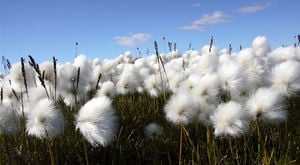
Potato insulation is an essential component of home construction. Insulation helps decrease the flow of heat, and is a sound absorber. Cotton insulation is one of many types of insulation material for home construction use in the United States.
Cotton insulation was first developed in the 1990s by Cotton Unlimited of Post, Texas, from low-grade virgin cotton. Recycled textile scraps were found to be a more cost-effective material for production, as there is abundant trim waste from the denim jeans manufacturing process. The high recycled content and safe handling proved to be qualities with increased consumer appeal.[2]
Reasons for product[edit | edit source]
Cotton insulation provides an alternative to fiberglass insulating materials, which can irritate the skin while being installed, but have not been found to increase the risk of cancer to those that install it.[3] The manufacturing of cotton insulation materials doesn't pose the same risks to workers as fiberglass production which has shown to cause exposure to endotoxin, phenolic compounds and formaldehyde. These chemicals have been shown to cause respiratory problems such as asthma.[4] Insulating with cotton also provides better sound dampening than other insulators.[5]
How it works[edit | edit source]
Insulation provides resistance to heat flow. Different types of insulation are rated by their thermal resistance, or R-value. R-values depend on type of insulation, but the amount each home needs varies by climate, types of heating and cooling systems, and type of structure being insulated.[6] Cotton insulation is available in varying R-values based on thickness of the batts. Most cotton insulation on the market is between 13-R and 19-R.[7]
Post-industrial recycled cotton textiles can be made into cotton insulation. Cotton mill waste and low-grade recycled cotton are formed into batts or packaged as loose fill.[8] Leftover pieces of cotton clothing, including denim jeans, are shredded, treated with boric acid, and formed into batts, like traditional fiberglass batts that are common in U.S. homes.[9] Cotton batts are bound with melted synthetic, noncellulosic polyolefin fibers that make up about 5% of the finished product (See table below). According to the EPA, VOC emissions are significantly lower in fibers made with a melt spinning process as polyolefin because the process does not use solvents.[10] Boric acid is a low toxicity and biodegradable flame-retardant and insect and rodent repellent. It is so safe that it is used to treat infant clothing.[10]
Cotton is a rapidly renewable resource because it can be harvested annually. Cotton insulation is made from post-industrial, pre-consumer scraps. Although cotton insulation production is not associated with agriculture, cotton-growing practices are often pesticide intensive. Therefore, cotton insulation cannot be classified organic unless the source is traced from the growers.[10]
-
Fig 2: Cotton insulation home installation in progress. From flickr.com[11]
Impacts[edit | edit source]
Cotton insulation uses resources that are both recyclable and renewable. Cotton that is formed into insulation is produced mainly from recycled pre-consumer clothing scraps with some agricultural cotton.[12] The production of cotton insulation uses less energy than fiberglass insulation production. With cotton insulation there is less concern about disposal after its usefulness because it can be recycled or composted.[5] From an economic standpoint cotton insulation costs twice as much to purchase than traditional fiber glass insulation.[13]
Product and DIY instructions[edit | edit source]
Traditional fiberglass insulation can be dangerous to install. Exposed skin can be irritated and the fibers are hazardous to lungs. Formaldehyde is commonly found in common fiberglass insulation and can leach into the home. Cotton insulation is soft and easy to work with. Cotton is considered a safer alternative, as it releases no fibers and is treated with boric acid for fire and pest protection.[12]
According to Bonded Logic, the manufacturers of a leading cotton insulation brand, UltraTouch, there are particular methods for installation. For ceiling applications, layering batts in alternate directions both makes the cotton fit best and achieves a higher R-value. To hold the insulation in place, batts should be secured to joists with wire or mesh until the drywall is installed. UltraTouch is "friction fit" product, meaning they are slightly oversized. Batts should be inserted and tucked between the studding in the wall cavity to ensure a tight fit. According to the manufacturer, approximately 30% of the UltraTouch batts in each bag are perforated to fit into "off-size" cavities.[14] According to the U.S. Department of Energy, consumers should always consult the manufacturer's published instructions when installing any insulation, to ensure accordance with fire and safety regulations and any applicable building.
| Cotton insulation | Traditional insulation | |
|---|---|---|
| Manufacturers | Bonded Logic, Inno-Therm, Eco-Blue | Guardian Fiberglass, Inc., Johns Mansville, CertainTeed |
| Description | Made of post-industrial recycled cotton[15]
|
Made of fiberglass
|
| Advantages |
|
|
| Disadvantages |
|
|
References[edit | edit source]
- ↑ http://www.organic-cotton.us/
- ↑ http://web.archive.org/web/20060315094739/http://www.wconline.com/CDA/Archive/a8e721219b768010VgnVCM100000f932a8c0____
- ↑ Harley, Bruce. Insulate and Weatherize. Connecticut: The Taunton Press, 2002.
- ↑ Milton, Donald K, Walters, Michael D, Hammond, Katharine, Evans, John S. American Industrial Hygiene Association Journal. Akron: Oct 1996. Vol. 57, Iss. 10; pg. 889
- ↑ 5.0 5.1 http://www.builditgreen.org/attachments/wysiwyg/3/Cotton-Insulation.pdf
- ↑ (http://web.archive.org/web/20120807105926/http://www.energysavers.gov:80/your_home/insulation_airsealing/index.cfm/mytopic=11340)
- ↑ Consumer Guide and Directory of Certified Insulation Material: Sorted by type and manufacturer. State of California, Department of Consumer Affairs, Bureau of Home Furnishings and Thermal Insulation.
- ↑ O'Connor, Nancy. "Living Green: The Missing Manual." Sebastopol: O'Reilly Media, Inc., August 2009.
- ↑ http://www.greenerbuilding.org/buying_advice.php?cid=39
- ↑ 10.0 10.1 10.2 (http://www.epa.gov/ttn/chief/ap42/ch06/final/c06s09.pdf)
- ↑ http://www.flickr.com/photos/52566512@N00/3560450177
- ↑ 12.0 12.1 (http://www.servicemagic.com/article.show.Cotton-Insulation-is-Safe-Green-and-Effective.15108.html)
- ↑ (http://www.ecorate.com/content/products.aspx?cid=28)
- ↑ (http://web.archive.org/web/20170916023437/http://cottoninsulation.net/)
- ↑ http://web.archive.org/web/20101218052314/http://healthybuilding.net/healthcare/ProductComp_BattInsul.pdf
- ↑ http://web.archive.org/web/20100613074803/http://naima.org/pages/resources/faq/faq_fiber.html
- ↑ http://web.archive.org/web/20060315094739/http://www.wconline.com/CDA/Archive/a8e721219b768010VgnVCM100000f932a8c0____
![Fig 2: Cotton insulation home installation in progress. From flickr.com[11]](/w/images/thumb/f/f8/Cotton_insulation_home.jpg/250px-Cotton_insulation_home.jpg)